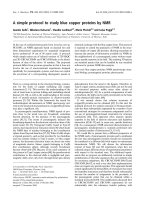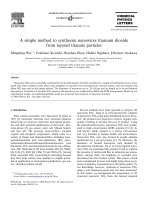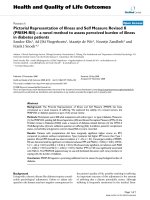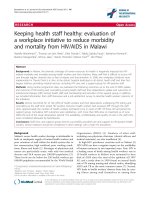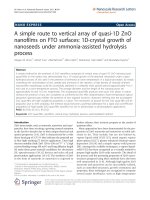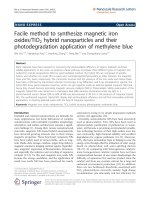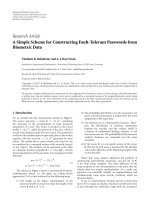- Trang chủ >>
- Khoa Học Tự Nhiên >>
- Vật lý
a simple method to synthesize nanowires titanium dioxide from layered titanate particles
Bạn đang xem bản rút gọn của tài liệu. Xem và tải ngay bản đầy đủ của tài liệu tại đây (401.3 KB, 4 trang )
A simple method to synthesize nanowires titanium dioxid e
from layered titanate particles
Mingdeng Wei
*
, Yoshinari Konishi, Haoshen Zhou, Hideki Sugihara, Hironori Arakawa
National Institute of Advanced Industrial Science and Technology (AIST), Energy Technology Research Institute,
AIST Tsukuba Central #5, 1-1-1, Higashi, Tsukuba, Ibaraki 305-8565, Japan
Received 11 September 2004; in final form 25 October 2004
Available online 11 November 2004
Abstract
Nanowires TiO
2
were successfully synthesized from layered titanate Na
2
Ti
3
O
7
particles by a simple soft chemical process. Com-
pared with other synthetic routes where some templates or reactants were introduced into reaction system, only raw material and
dilute HCl were used in this simple method. The diameters of nanowires are ca. 20–100 nm and the length up to several hundred
micrometers. Formation of brookite TiO
2
phase in the nanowires was confirmed by XRD and TEM measurement. Based on our
experimental results, an exfoliating-splitting model was proposed for formation of nanowire structure.
Ó 2004 Elsevier B.V. All rights reserved.
1. Introduction
Since carbon nanotubes were discovered by Ijima in
1991 [1], nanoscale materials have attracted immense
interest due to structure, electronic and optical proper-
ties and their potential applications in electronic-, pho-
tonic-device [2], gas sensor, solar cell, lithium battery
and fuel cell. The growing Ônano-toolboxÕ contains
organic and inorganic components, which come in a
variety of shapes and dimensionalities, includi ng nano-
particles/quantum dots (zero-dimension, 0D), nano-
tubes/nanorods/nanobelt/nanoribbons/nanowires (one
dimension, 1D), and nanosheets/nanohorns (two dimen-
sion, 2D). Materials in 1D form include TiO
2
[3],MnO
2
[4],V
2
O
5
[5], ZnO [6], CdSe [7] and MoS
2
[8]. Among
them, nanoscale TiO
2
is particularly interesting because
they have large surface area, leading to a higher poten-
tial of application in environment purification, gas sen-
sor, and photovoltaic cell [9].
Several methods have been reported to prepare 1D
nanowires TiO
2
. Jiang et al. [10] reported the synthesis
of nanowires TiO
2
using polyol-mediated process. How-
ever, the products are required to remove organic com-
pound, resulting in increase the cost of product. Using
the hydrothermal process, nanowires TiO
2
were synthe-
sized in high concentration KOH solution [11,12].As
well known, alkali solution is a strong corrosiveness
and very harmful to human health and environment.
Nanowires TiO
2
were also formed in anodic alumina
membranes by a sol–gel process [13–15]. However, the
diameters of formed nanowires were decided by
through-hole membrane. Xu et al. [16] prepared nano-
wires TiO
2
via annealing TiS
2
precursor with or without
the presence of molten-salt flux in ammonia gas atmos-
phere. Among them, the templates or reactants were
introduced into the reaction system. This means a much
more complicated process, and might bring about an in-
crease of impurity concentration in the final product. To
our knowledge, however, synthesis of nanowires TiO
2
using a soft chemical process has not been concerned.
In this Letter, we investigated the preparation of 1D
structural nanowire TiO
2
from the layered material
0009-2614/$ - see front matter Ó 2004 Elsevier B.V. All rights reserved.
doi:10.1016/j.cplett.2004.10.114
*
Corresponding author. Fax: +81 29 8616771.
E-mail address: (M. Wei).
www.elsevier.com/locate/cplett
Chemical Physics Letters 400 (2004) 231–234
Na
2
Ti
3
O
7
particles using a soft chemical process, with
no existence of reactants or templates, only the raw
material and dilute HCl were used. Further, a formation
mechanism of nanowires TiO
2
was proposed according
to the results of SEM, TEM and XRD.
2. Experimental
2.1. Preparation of samples
The layered material Na
2
Ti
3
O
7
was synthesized from
Na
2
CO
3
(Wako) and TiO
2
(ST-01, Ishihara Sangyo
Kaisha LTD.) in the stoichiometrical ratio 1:3. The pow-
ders were mixed together and repeatedly ground in an
agate mortar, and calcined at 1000 °C for 2 h in the air.
Synthesis of nanowires TiO
2
was performed by a
hydrothermal soft chemical process. In a typical synthe-
sis, 0.15 g Na
2
Ti
3
O
7
was dispersed into a 15 ml 0.05–0.1
M HCl solution, then was transferred into a 30 ml auto-
clave, and kept at 140–170 °C for 3–7 days. The as-prod-
uct was filtered, washed with H
2
O, and finally dried at
60 °C for 4 h.
2.2. Characterization of samples
X-ray powder diffraction (XRD) patterns were re-
corded using a diffractometer (Mac Science). Scanning
electron microscope (SEM) and transmission electron
micrographs (TEM) were taken on a TOPCON DS
instrument and a JEOL instrument, respectively.
3. Results and discussion
Fig. 1 shows SEM images of the raw material Na
2-
Ti
3
O
7
and the sample obtained at 170 °C for 7 days. It
is very different between the raw material Na
2
Ti
3
O
7
and the sample. Only particles were observed for the
raw material, as depicted in Fig. 1a. The SEM image
of the sample shown in Fig. 1b has revealed the presence
of numerous nanowires with typical lengths ranging
from several micrometers to several tens of micrometers.
It notice d that some brush-like sheets attached to some
of the nanowires were observed (Fig. 1b, circle A). In
addition, some particle aggregates and sheets with rolled
edge were also found (Fig. 1b, circle B). These nano-
wires lie close to each other. Further magnification
clearly shows that the diameter of these nanowires is
ca. 20–100 nm (see Fig. 1c).
The formation of numerous nanowires was further
confirmed by TEM measurement. Fig. 2 depicts TEM
images of the sample containing lots of nanowires.
The low magnification image, as shown in Fig. 2a, indi-
cates that the size and length of nanowires are same as
those observed in SEM experiment. One single nanowire
was selected, as shown in Fig. 2b. It is clear that the end
of nanowire is cone-shaped. Further magnification
clearly shows the single-crystalline nature of sample (in-
set in Fig. 2c, left upper), and the lattice fringes corre-
spond to a d-spacing of 0.22 nm.
XRD patterns of the raw material Na
2
Ti
3
O
7
and the
product containing lots of nanowire were depicted in
Fig. 3. The former shows a typical profile of layered
compound, and could be indexed to a layered titanate
Na
2
Ti
3
O
7
[17]. The latter is obviously different from
the former. TiO
2
as the main phase was observed besides
the phase of H
2
Ti
3
O
7
(JCPDS 47-0561), and it could be
indexed to a brookite TiO
2
with an orthorhom bic struc-
ture (JCPDS 72-1582). The d
202
-spacing is 0.22 nm. This
is in agreement with the lattice fringe obtained from
TEM image, indicating that the nanowires in product
are TiO
2
with brookite structure. Formation of
H
2
Ti
3
O
7
was contributed to ion-exchange reaction. In
Fig. 1. SEM images of (a) the raw material Na
2
Ti
3
O
7
together with the
product containing lots of nanowires (b) low magnification and
(c) high magnification.
232 M. Wei et al. / Chemical Physics Letters 400 (2004) 231–234
the dilute HCl solution, Na
+
in the raw material Na
2-
Ti
3
O
7
was replaced by H
+
to form H
2
Ti
3
O
7
phase.
In this study, only the raw material Na
2
Ti
3
O
7
and di-
lute HCl were used, no any templates or reactants were
introduced into the reaction system. Based on the exper-
imental results of XRD, SEM and TEM, an exfoliating-
splitting model of nanowires formation from layered
Na
2
Ti
3
O
7
was proposed, as illustrated in Scheme 1.It
is well known that Na
+
cations reside between edge-
shared [TiO
6
] octahedral layers in Na
2
Ti
3
O
7
[17]. The
strong static interaction between the Na
+
cations and
[TiO
6
] unit holds the layers together tightly. Under
hydrothermal conditions, Na
+
cations will be replaced
gradually with intercalated H
þ
3
O molecule into the inter-
layer space of [TiO
6
] sheets. Because the size of H
þ
3
Ois
larger than that of Na
+
cation, the interlayer distance
was enlarged, resulted in weakened static interaction be-
tween neighboring [TiO
6
] octahedral sheets. As a result,
the layered compound Na
2
Ti
3
O
7
particles were gradu-
ally exfoliated. In the meantime, Na
+
in Na
2
Ti
3
O
7
was
exchanged by H
+
in the dilute HCl solution to form
numerous H
2
Ti
3
O
7
sheet-shaped products. The nano-
sheet does not has an inversion symmetry, i.e. the layer
is asymmetric, an intrinsic tension exists which might
gradually tends to roll from the edges of nanosheets
[18]. In order to release the strong stress and lower the
total energy, the nanosheets are splitted, resulting in for-
mation of the nanowires. This formation model can be
used to explain the formation of brush-like nanosheets
observed in SEM images. There exist three procedures
Scheme 1. An exfoliating-splitting model of nanowires formation from
the layered Na
2
Ti
3
O
7
particles by a soft chemical process.
Fig. 2. TEM images of the sample containing lots of nanowires (a) low
magnification, (b, c) high magnification.
Fig. 3. XRD patterns of (a) the raw material Na
2
Ti
3
O
7
and
(b) product containing lots of nanowires.
M. Wei et al. / Chemical Physics Letters 400 (2004) 231–234 233
in the reaction: (i) the exfoliation from layered Na
2
Ti
3
O
7
particles to form nanosheets; (ii) the split of nanosheets
to form nanowires; (iii) the exfoliation accompanied by
splitting to form brush-like nanosheets. Therefore, the
formation of brush-like nanosheets can be contribu ted
to fact that both exfoliating and splitting are incomplete.
4. Conclusions
In this Letter, a simple method involving a soft chem-
ical process started from the layered compound Na
2-
Ti
3
O
7
particles has been used to synthesize single-
crystal TiO
2
nanowires. According to the comparative
experimental results, an exfoliating-splitting model was
proposed for formation of nanowire structure. Based
on the simple method with no participation of catalysts
or templates and requiring no expensive and precise
equipment, will greatly reduce the production cost,
and thus offer great opportunity for scale-up prepara-
tion of 1D nanostructure materials.
Acknowledgement
M.D.W. acknowledges Mr. M. Ichihara of Institute
of Solid State Physics at Tokyo University for his help-
ful in the TEM experiments.
References
[1] S. Ijima, Nature (London) 354 (1991) 56.
[2] K. Vinodgopal, S. Hotchandani, P.V. Kamat, J. Phys. Chem. 97
(1993) 9040.
[3] T. Kasuga, M. Hiramatsu, A. Hoson, T. Sekino, K. Niihara,
Langmuir 14 (1998) 3160.
[4] X. Wang, Y. Li, J. Am. Chem. Soc. 124 (2002) 2880.
[5] L Q. Mai, W. Chen, Q. Xu, Q Y. Zhu, C H. Han, J F. Peng,
Solid State Commun. 126 (2003) 541.
[6] X H. Kong, X M. Sun, X L. Li, Y D. Li, Mater. Chem. Phys.
82 (2003) 997.
[7] J.A. Navio, G. Colvn, J.M. Herrman, J. Photochem. Photobiol.
A: Chem. 108 (1997) 179.
[8] Y. Feldman, E. Wasserman, D.A. Srolovitz, Science 267 (1995)
222.
[9] M. Adachi, Y. Murata, M. Harada, Chem. Lett. 29 (2000) 942.
[10] X H. Jiang, Y L. Wang, T. Herricks, Y N. Xia, J. Mater.
Chem. 14 (2004) 695.
[11] B L. Wang, Q. Chen, R H. Wang, L M. Peng, Chem. Phys.
Lett. 376 (2003) 726.
[12] M. Watanabe, Y. Bando, M. Tsutsumi, J. Solid State Chem. 28
(1979) 397.
[13] Y. Lei, L D. Zhang, J C. Fan, Chem. Phys. Lett. 338 (2001) 231.
[14] Y. Lei, L D. Zhang, G W. Meng, G H. Li, X Y. Zhang, C H.
Liang, W. Cheng, S.X. Wang, Appl. Phys. Lett. 78 (2001) 1125.
[15] Z. Miao, D S. Xu, J H. Ouyang, G L. Guo, X S. Zhao, Y Q.
Tang, Nano Lett. 2 (2002) 717.
[16] C K. Xu, Y J. Zhan, K Q. Hong, G H. Wang, Solid State
Commun. 126 (2003) 545.
[17] S. Andersson, A.D. Wadsley, Acta Crystallogr. 14 (1961) 1245.
[18] S. Zhang, L M. Peng, Q. Chen, G H. Du, G. Dawson, W Z.
Zhou, Phys. Rev. Lett. 19 (2003) 2561.
234 M. Wei et al. / Chemical Physics Letters 400 (2004) 231–234
